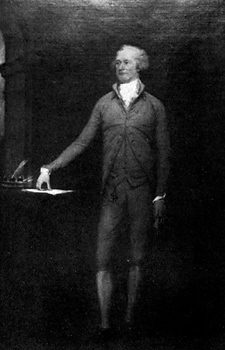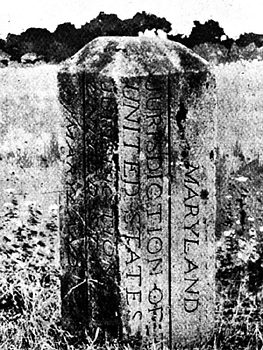The Life and Legacy of Alexander Hamilton
|

|
|
Share This Page
|
|
|
|
|
|
|
Follow This Site

|
 |
|
|
|
|

|
Part 5: Newfound Power and Fame
One of the first things that the new Government did was have elections. George Washington was elected unanimously as the new country's first President. And one of his first political appointments was making Hamilton Secretary of Treasury.
 The position was an especially important one because the country was in financial ruin. The Government owed huge debts to both the states and to other countries for supplying the war effort. Much of the industry in the country was disrupted or in bad shape, also as a result of the war. The country needed rebuilding, and it needed money to do it.
The position was an especially important one because the country was in financial ruin. The Government owed huge debts to both the states and to other countries for supplying the war effort. Much of the industry in the country was disrupted or in bad shape, also as a result of the war. The country needed rebuilding, and it needed money to do it.
One of Hamilton's main ideas was to generate large sums of money for the Government by taking out loans to wealthy Americans, British, and others who would be willing to loan money at a reduced rate. The short-term effect would be a major infusion of cash into the Government; the long-term effect would be a payback of the loans over long periods of time. In return, these wealthy individuals would be predisposed to invest in the American economy in the future, thus (to Hamilton's way of thinking) ensuring future income as well as immediate.
He also proposed that the federal government assume all of the money currently owed by the states. This was particularly objectionable to the states that had money to begin with and had already worked very hard throughout the few years since the end of the war to pay off that debt.
One of the main opponents of Hamilton's ideas was none other than James Madison, the man who befriended Hamilton and who helped him write The Federalist Papers. Madison, at heart, favored the common man, where Hamilton did not. Madison wanted a federal government, but he wanted that government to protect the rights of its citizens, to exist to protect those rights—not the reverse.
 Still, Hamilton had his supporters as well. The debate was fierce at times and civil at other times. What finally decided the matter was a fine bit of political compromise instigated by Secretary of State Thomas Jefferson. Jefferson invited both Madison and Hamilton to dinner and urged them to come together over the economic plan. He urged them to attach the economic plan to a plan to place the new nation's capitol. Jefferson strongly hinted that if the capitol were placed in the South, then he would work very hard to get southern representatives to support the entire deal. Hamilton agreed, and the capitol was placed in land bordering Virginia and Maryland.
Still, Hamilton had his supporters as well. The debate was fierce at times and civil at other times. What finally decided the matter was a fine bit of political compromise instigated by Secretary of State Thomas Jefferson. Jefferson invited both Madison and Hamilton to dinner and urged them to come together over the economic plan. He urged them to attach the economic plan to a plan to place the new nation's capitol. Jefferson strongly hinted that if the capitol were placed in the South, then he would work very hard to get southern representatives to support the entire deal. Hamilton agreed, and the capitol was placed in land bordering Virginia and Maryland.
The battles were just beginning, however. One of Hamilton's pet projects was a national bank. Following the British model, Hamilton proposed a Bank of the United States, which would be a national bank run by a private board of directors. Private ownership, Hamilton argued, would prevent the very construction that opponents of the bank feared. But Madison countered that the bank would favor the wealthy at the expense of the "common" Americans. He also argued that the idea of a national bank was unconstitutional because the Constitution did not expressly provide for one.
 Hamilton won this fight, though, in an almost straight split between North and South. Congress passed the bill and sent it on to President Washington, who asked for advice from Hamilton, Jefferson, and Attorney General Edmund Randolph before finally signing it, in February 1791.
Hamilton won this fight, though, in an almost straight split between North and South. Congress passed the bill and sent it on to President Washington, who asked for advice from Hamilton, Jefferson, and Attorney General Edmund Randolph before finally signing it, in February 1791.
A consequence of these political fights was the formation of the nation's first two political parties, the Federalists (headed by Hamilton) and the Democratic-Republicans (headed by Jefferson and Madison).
Next page > Wars and Inside Out > Page 1, 2, 3, 4, 5, 6, 7, 8, 9



 The position was an especially important one because the country was in financial ruin. The Government owed huge debts to both the states and to other countries for supplying the war effort. Much of the industry in the country was disrupted or in bad shape, also as a result of the war. The country needed rebuilding, and it needed money to do it.
The position was an especially important one because the country was in financial ruin. The Government owed huge debts to both the states and to other countries for supplying the war effort. Much of the industry in the country was disrupted or in bad shape, also as a result of the war. The country needed rebuilding, and it needed money to do it. Still, Hamilton had his supporters as well. The debate was fierce at times and civil at other times. What finally decided the matter was a fine bit of political compromise instigated by Secretary of State
Still, Hamilton had his supporters as well. The debate was fierce at times and civil at other times. What finally decided the matter was a fine bit of political compromise instigated by Secretary of State  Hamilton won this fight, though, in an almost straight split between North and South. Congress passed the bill and sent it on to President Washington, who asked for advice from Hamilton, Jefferson, and Attorney General
Hamilton won this fight, though, in an almost straight split between North and South. Congress passed the bill and sent it on to President Washington, who asked for advice from Hamilton, Jefferson, and Attorney General 
